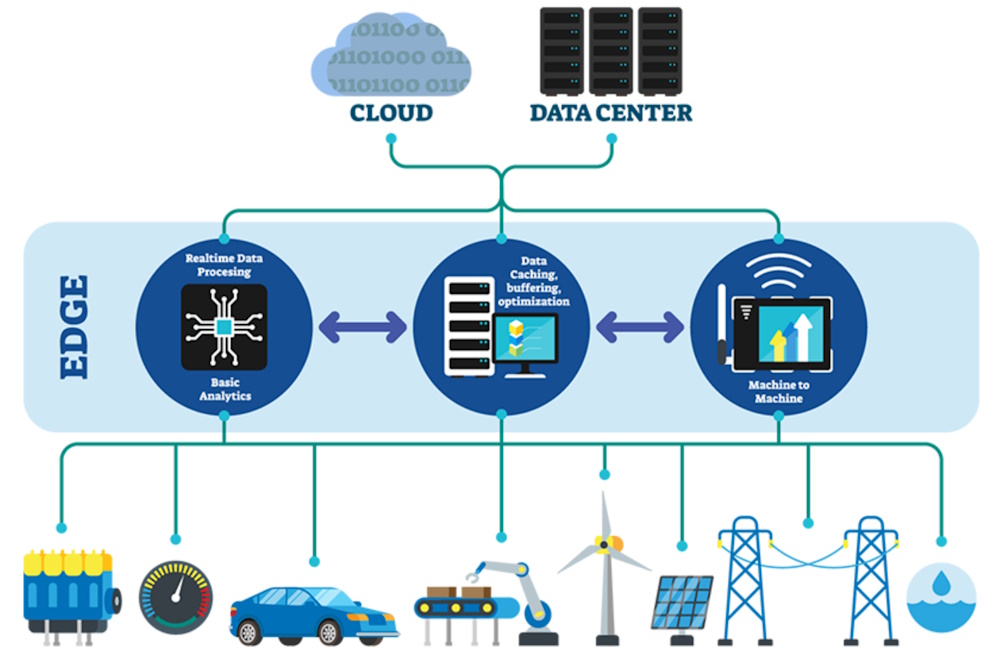 Edge AI
Edge AI
Edge Artificial Intelligence integrates AI with edge computing
Related: AI in our Everyday Lives
Edge AI or on-device AI refers to the deployment of AI algorithms and AI models on devices at the "edge" of a network, typically local devices like smartphones and wearables, rather than relying on cloud-based or centralized data centers.
The AI models are trained using machine learning on large datasets and then deployed onto the devices' onboard memory. Once deployed, these models can analyze sensor data, images, audio, and other inputs locally, enabling devices to perform image and speech recognition, predictive maintenance, and more.
These edge devices process data locally and make decisions in real-time, without requiring a continuous connection to the cloud. Examples of edge devices include smartphones, IoT (Internet of Things) devices, autonomous vehicles, drones, industrial robots, sensors, and even small embedded systems like Raspberry Pi. Here's an illustration:

 Benefits of Edge AI
Benefits of Edge AI
- Scalability: Eliminates dependence on centralized infrastructure, enabling wide-scale deployment across devices.
- Energy Efficiency: Modern edge AI chips are designed for low power consumption, extending device battery life.
- Cost-Effectiveness: Reduces the costs associated with cloud storage, bandwidth, and data processing.
- Enhanced Security: Local processing minimizes data transmission risks and potential breaches.
 Key Features of Edge AI
Key Features of Edge AI
Edge AI enables real-time data analysis and decision-making
This is important for applications like autonomous driving, robotics, and video analytics that require immediate feedback.
This immediate processing allows for timely detection of changes in a person's health status, for example, which is needed for early health prognosis and intervention. By reducing the need to transfer large volumes of data to central systems, edge computing minimizes potential data exposure and enhances data privacy. This is particularly beneficial in applications where rapid response is essential, such as in patient monitoring systems and predictive maintenance in industrial settings. Here are some other key features:
- Reduced Latency: Data processing occurs locally on the device, significantly reducing the delay caused by sending data to a cloud server and waiting for a response.
- Enhanced Privacy: Since data does not need to leave the device, sensitive information is less likely to be exposed to breaches or misuse.
- Lower Bandwidth Usage: By processing data locally, edge AI reduces the need for constant communication with the cloud, conserving bandwidth and lowering costs.
- Offline Functionality: Edge AI systems can function even without an internet connection, which is especially beneficial in remote or unstable network environments.
 Applications of Edge AI
Applications of Edge AI
There are numerous Edge AI devices covering a wide range of applications
- Autonomous Vehicles: Vehicles equipped with Edge AI can process data from cameras, LiDAR, and sensors to make real-time driving decisions without depending on a cloud server.
- Smart Devices: Virtual assistants like Amazon Alexa or Google Assistant use edge processing for wake-word detection.
- Healthcare: Portable medical devices equipped with Edge AI can monitor patients, analyze data, and provide alerts in real time.
- Security: Cameras with Edge AI can perform facial recognition, motion detection, and object tracking directly on the device.
- Manufacturing: AI-powered robots in factories analyze sensor data and optimize processes locally to improve efficiency and reduce downtime.
- Retail: Smart point-of-sale (POS) systems and checkout-free stores (e.g., Amazon Go) use Edge AI for real-time inventory tracking and customer service.
- Drones: Edge AI-powered drones can navigate autonomously, detect objects, and gather environmental data without relying on cloud connectivity.
 Getting Started with Edge AI
Getting Started with Edge AI
For the person who wants hands-on knowledge and experience with Edge AI applications
❶ Understand Edge AI Applications
Familiarize yourself with common applications for Edge AI, such as smart home devices (voice assistants, security cameras with facial recognition), Industrial IoT (predictive maintenance in manufacturing), healthcare (wearable health monitoring devices), and retail (customer tracking and personalized recommendations).
❷ Select the Right Hardware
Choose hardware devices that meet your AI requirements (see below). For example:
- Microcontrollers: Raspberry Pi, Arduino, ESP32 (for lightweight tasks).
- Single-Board Computers: NVIDIA Jetson Nano, Google Coral Dev Board (for computer vision).
- Edge Servers: Intel Movidius Myriad, Qualcomm Snapdragon AI processors.
❸ Choose AI Frameworks for Edge Deployment
Many frameworks are optimized for edge environments. These include:
- TensorFlow Lite: For running TensorFlow models on mobile and IoT devices.
- PyTorch Mobile: Lightened PyTorch version for mobile AI.
- OpenVINO: Intel's toolkit for optimized inference.
- ONNX Runtime: For cross-platform model deployment.
- Edge Impulse: Ideal for sensor and IoT AI applications.
❹ Optimize AI Models for Edge Devices
Apply optimization techniques for efficient deployment like quantization, pruning, and knowledge distillation.
- Quantization reduces the precision of the numerical values (weights and activations) used in AI models, typically moving from floating-point numbers (like 32-bit floating-point) to lower precision formats (like 8-bit integers).
- Pruning removes unnecessary parameters (weights or neurons) from a neural network to make it smaller and more efficient.
- Knowledge distillation transfers knowledge from a larger, more accurate model (called the teacher model) to a smaller, more efficient model (the student model).
❺ Deploy AI Models
Load and run the AI model directly on the edge device. You can use TensorFlow Lite interpreters for real-time inferencing. You can optimize device-specific configurations such as NVIDIA Jetson for GPU acceleration.
❻ Testing and Monitoring
Test the accuracy and inference speed on the device. Monitor power usage and latency. Debug issues related to performance or memory constraints.
❼ Maintain and Update Models
Edge AI systems need updates to improve performance. You can create pipelines for Over-the-Air updates and monitor device performance to detect drift in model accuracy.
 Edge AI Hardware
Edge AI Hardware
Hardware capable of running AI models efficiently and economically
Some popular hardware platforms include:
- NVIDIA Jetson Series: Compact AI modules for autonomous machines and edge devices.
- Google Coral: Edge TPU-based hardware for efficient ML inference on edge devices.
- Intel Movidius Myriad: Chips designed for computer vision and AI tasks at the edge.
- Raspberry Pi with AI Accelerators: Affordable and customizable for lightweight AI applications.
- Qualcomm Snapdragon: AI-powered processors widely used in smartphones and IoT devices.
 Challenges of Edge AI
Challenges of Edge AI
- Edge devices typically have less computational capacity compared to cloud servers, requiring optimized models.
- AI models need to be compressed or pruned to fit the memory and processing constraints of edge devices.
- Adapting AI solutions to work across a wide range of edge hardware can be challenging.
- Keeping models up-to-date on numerous devices is logistically complex compared to centralized cloud systems.
 Future of Edge AI
Future of Edge AI
The proliferation of 5G networks will complement Edge AI, allowing faster communication between devices. Edge AI will be central to the growing IoT ecosystem, enabling smarter and more autonomous devices. The development of AI-specific chips (like neuromorphic processors) will further enhance the capabilities of edge AI devices. Advances in techniques like quantization, pruning, and knowledge distillation will make it easier to run complex models on edge devices.